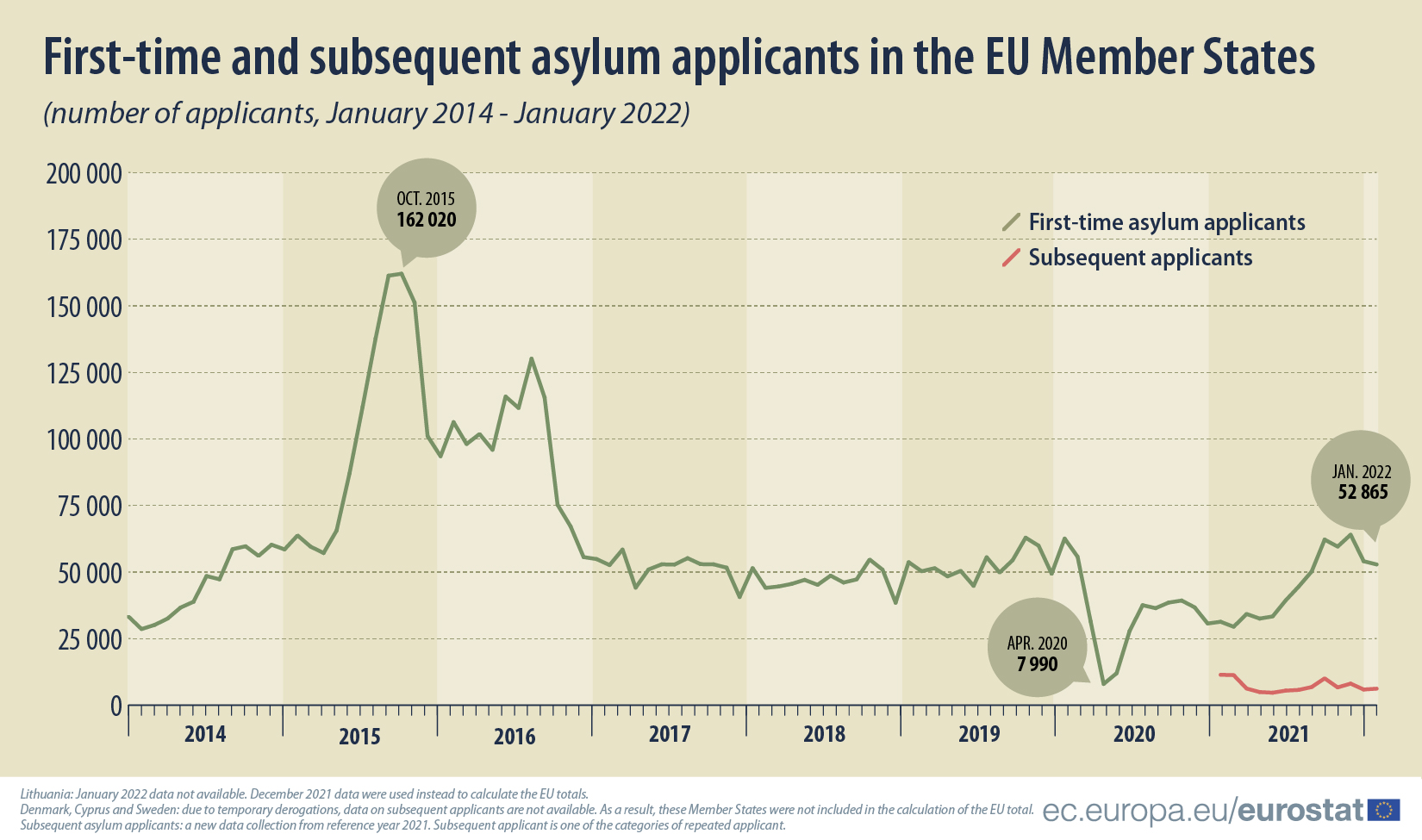In January 2022, 52 865 first-time asylum applicants (non-EU citizens) applied for international protection in the EU Member States, up by 69% compared with January 2021 (31 345), yet down by 2% compared with December 2021 (54 090).
Furthermore, in January 2022, there were also 6 225 subsequent applicants (people who reapplied for asylum after a decision had been taken on a previous application). This was down 46% when compared with January 2021 (the first month for which these new data were collected), yet up 5% compared with December 2021.
This information comes from monthly asylum data published by Eurostat today. The article presents a handful of findings from the more detailed Statistics Explained article on monthly asylum statistics published for the first time today.
Source dataset: MIGR_ASYAPPCTZM
Most first-time asylum applicants were Syrians and Afghans
In January 2022, Syrians were the largest group of persons seeking asylum (7 885 first-time applicants). They were followed by Afghans (7 375), ahead of Venezuelans (3 405), Colombians (2 365), Turks and Iraqis (both 2 340).
Almost a third of first-time applicants requested asylum in Germany
With 15 835 first-time applicants registered in January 2022, Germany accounted for 30% of all first-time applicants in the EU. Germany was followed by France (9 985, 19%), ahead of Spain (7 675, 15%), Italy (4 340, 8%) and Austria (3 175, 6%). These five Member States together accounted for over three-quarters (78%) of all first-time applicants in the EU.
2 310 unaccompanied minors applying for asylum in the EU, of which almost half were Afghans
The amendment of the Council Regulation (EC) No 862/2007 adopted in June 2020 introduced new statistics, as well as increasing the frequency, timeliness and the level of detail of the statistics from 2021, including more frequent and detailed information on unaccompanied minors who represent a particularly vulnerable group seeking protection.
- In January 2022, 2 310 unaccompanied minors applied for asylum for the first time, up by 73% compared with January 2021 (1 335) and down by 27% compared with December 2021 (3 155).
- Most unaccompanied minors who lodged asylum applications in January 2022 came from Afghanistan (1 065), Syria (435) and Somalia (165).
- Austria (505), Germany (415), Belgium (295) were the three Member States which received the highest numbers of asylum applications from unaccompanied minors in January 2022.
In addition, Eurostat started to collect new data on asylum applications under accelerated procedure, on applicants benefiting from material reception conditions and on types of withdrawals of asylum applications. The datasets with the new statistics are continuously published in the database.
For more information:
- Statistics Explained article on monthly asylum statistics
- Statistics Explained article on annual asylum statistics
- Dedicated section on migration and asylum statistics
- Database on asylum statistics
Methodological notes:
- Lithuania: January 2022 data not available. December 2021 data were used instead to calculate the EU totals.
- Denmark, Cyprus and Sweden: due to temporary derogations, data on subsequent applicants are not available. As a result, they were not included in the calculation of the EU total. A complete list of such derogations is provided in the Commission Implementing Decision (EU) 2021/431.
- France, Cyprus and Poland: January 2022 data on unaccompanied minor asylum applicants not available. As a result, the EU total was estimated.
- Subsequent asylum applicants: a new data collection from reference year 2021. Subsequent applicant is one of the category of repeated applicant.
- Statistics on asylum applicants considered to be unaccompanied minors presented in the article refers to the age accepted by the national authorities, however before the age assessment procedure was carried out/completed (i.e. it refers to the age as claimed by the applicant).
To contact us, please visit our User Support page.
For press queries, please contact our Media Support.


